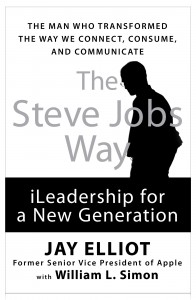Steve Jobs Way by Jay Elliot
Posted by Orrin Woodward on April 15, 2011
 I recently finished a fantastic book on Steve Jobs by Jay Elliot called, The Steve Jobs Way. If you are looking for a book that will open up the mind, passion, and character of Jobs, then look no further. Elliot worked with Jobs during his early years of Apple and witnessed first hand many of Jobs critical lessons on his way to leadership greatness. Here is a snippet of a chapter on purpose using some of the lessons that I learned from this book and Jim Collin’s HedgeHog Concept in Good to Great. Anyone can move from good to great if they can discover their purpose by intersecting their passions, potentials, and profits. Elliot’s book reveals how Jobs did this. God Bless, Orrin Woodward
I recently finished a fantastic book on Steve Jobs by Jay Elliot called, The Steve Jobs Way. If you are looking for a book that will open up the mind, passion, and character of Jobs, then look no further. Elliot worked with Jobs during his early years of Apple and witnessed first hand many of Jobs critical lessons on his way to leadership greatness. Here is a snippet of a chapter on purpose using some of the lessons that I learned from this book and Jim Collin’s HedgeHog Concept in Good to Great. Anyone can move from good to great if they can discover their purpose by intersecting their passions, potentials, and profits. Elliot’s book reveals how Jobs did this. God Bless, Orrin Woodward
Steve Jobs, Founder and CEO of Apple, portrays the genius of the HedgeHog Concept in both his personal and professional life. Jobs may have the firmest grasp of consumer preferences of any current CEO, intuitively understanding the customers love of simplicity, elegance of design, and the “cool” factor. Moreover, his obsession, according Elliot, “is a passion for the product . . . a passion for product perfection.” With his passion aligning beautifully with his potential, Jobs’ aforementioned intuitive understanding of customer desires, the last piece of the puzzle for him was to determine how to make money by following his passion and potential. Apple, although not the top seller of computers, is the most profitable, offering a unique product in a marketplace of Window’s software clones, not too mention innovative product offerings like the Ipod, Ipad, and Iphone, all of which are revolutionizing the high tech field. Chris Brady, best selling co-author of Launching a Leadership Revolution and Apple connoisseur, defined Apple’s Hedgehog Concepts in this way, “To deliver incredibly creative and “cool” technology that is intuitively useful and reliable for any class of user – particularly the user who doesn’t care to know about the intricacies of a hammer in order to make productive use of one. (In other words, to make the technology invisible and the usability and dependability dominant).” Jobs wanted, not only an intuitive product, but also one that created such an experience of satisfaction, the customer would feel emotionally attached to the product, sharing his experience with others.
Not surprisingly, Job’s individual Hedgehog Purpose and Apple’s Hedgehog Concept, closely resemble on another, since both emerge out of the intersection of Job’s passion, potential, and profits, with Apple exemplifying Emerson’s shadow of a great man. Although many talented people work with Jobs, it’s his purpose, his vision, and his principles that move the Apple ship forward. Mac engineer Trip Hawkins concurs, describing Jobs as having, “a power of vision that is almost frightening. When Steve believes in something, the power of that vision can literally sweep aside any objections, problems or whatever. They just cease to exist.” Elliot concurred, writing, “The Mac and every product since then are more than ‘just products.‘ They are a representation of Steve Jobs’ intense commitment. Visionaries are able to create great art or great products because their work isn’t nine-to-five. What Steve was doing represented him; it was intuitive but inspired.” Purposeful people like Jobs infect their entire community with purpose, bringing a communities passion, potential, and profits to the forefront. Needless to say, purpose, in an organization’s culture, positively affects the company’s culture, thus its bottom line. Elliot elaborates, “When you believe in your product and people as totally as Steve does, your people stick with you. Apple had one of the highest retention rates in Silicon Valley,” mainly because Job’s purpose, vision, and principles united the Apple community into highly effective culture. Jobs, speaking at the Stanford commencement ceremonies, described his belief in a life’s purpose, “Again, you can’t connect the dots looking forward; you can only connect them looking backwards. So you have to trust that the dots will somehow connect in your future. You have to trust in something — your gut, destiny, life, karma, whatever. This approach has never let me down, and it has made all the difference in my life.”
3 Responses to “Steve Jobs Way by Jay Elliot”
Sorry, the comment form is closed at this time.








wildtarg said
Wow. Thanks a lot for the excerpt, Orrin. I will have to read this book soon.
I really like Trip Hawkins’ quote. I normally take exception to bumper sticker philosophy, but here’s one that made it through my filter:
“The best way to predict the future is to help create it.”
Keep going, we’re with you…
Gabriel Weeden
Tim Stephens said
“a power of vision that is almost frightening. When Steve believes in something, the power of that vision can literally sweep aside any objections, problems or whatever. They just cease to exist.”
Love it! Without a VISION, the people perish. So glad to be aligned with a company that has a HUGE one!
claver conquergood said
a power of vision that is almost frightening, i think that describes you orrin. with you to a million, and your vision!